The origins of the church
It is thought that a small chapel was built
here in about 1100. Additions to this modest
building through the centuries have given us
the fine landmark we see today.
We know little about the history of St Luke’s
before 1850 because of a fire that destroyed
most of the church records.
We do know, however, that in 1293 the Bishop of
Coventry and Lichfield ruled that despite not
having a graveyard of its own, this was a church
and not a chapel. Eventually it gained a
churchyard, which was consecrated in 1330. In this
same century, the church was almost entirely
rebuilt. Most of the internal walling in the western
part of the nave and the four western-most arches
of the two arcades date from this period.

This view of the church by J. C. Buckler dates from 1841
Courtesy of the Trustees of the William Salt Library, Stafford
Church life before the Reformation
During the 15th century the church would have been a focal
point for the community. People would gather here to meet
friends and listen to the daily Mass. The bells would have
acted as the local clock – probably the only formal timekeeper
in the whole community.
Before the Reformation that occurred in the 16th century,
priests tended not to preach sermons. They recited the
service in Latin, which few people understood. There were no
pews in the church, so the congregation had to stand or
kneel, and men and women were separated. If there was a
bench against the wall, the old and infirm could sit on it –
hence the expression ‘the weakest go to the wall’.

The earliest known photograph of the church, c1870.
Image courtesy of the Conduit Trust
The Reformation to the present day
After the Reformation, a vestry (where the vicar kept
his vestments) and an upper west gallery were added.
With the growing population of the 18th and 19th
centuries, larger congregations needed to be
accommodated, so two more galleries were built, one
in 1720 and one in 1810.
Later in the 19th century, the church was further
upgraded. A new chancel was added with a new
combined vestry and organ chamber. It is reputed that
up to this point an organ had to be carried every
Sunday to the church and back from the Rising Sun
public house that was across the road!
In 1839 a vicarage was added to St Luke’s, but it was demolished in 1973 to make way for a new by-pass.

This tablet inside the church commemorates Napier Henry Walker,
who died in 1916. He was headmaster of Walhouse School in Cannock
for 36 years, and this memorial was erected by his former pupils.
Image courtesy of the Conduit Trust
|

A postcard of the church, published some time before 1930.
Gas lighting was installed in the church in the early 20th century,
so the lights you can see at the end of the pews are probably lit by gas.
Image courtesy of Ray Smith

The bells of St Luke’s in 1928. On the left is the Reverend Price,
and on the right is the verger, Mr Benton.
Image courtesy of the Conduit Trust
The church bells
Through the ages, the number of bells at St Luke’s church has increased. In 1553, an inventory shows that there were four bells. By 1849, there were six bells, and by 1923 they had been recast and increased to eight. In 1995 the bell-ringers of St Luke’s launched an appeal to increase the peal to ten bells, which raised £30,000. Six new bells were cast, and the new peal of ten bells was dedicated on 30 March 1996.
The church grounds
When the churchyard was landscaped in 1949 and 1950, the gravestones were laid flat. You can see them around the church and its boundary wall.

|
Bells today are usually much
more musical than they were
in the past. The material and
shape both affect the sound
given by a bell.
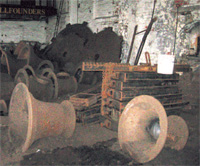 |
Bell moulds in the Casting Hall |
| |
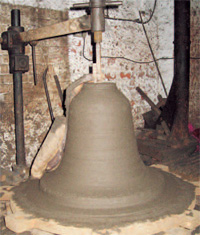 |
A timber bell crook is used to
form the shape of the bell |
| |
The right material for a bell is
bronze (a mixture of copper and
tin). Brass (copper and zinc)
works for town criers’ bells but,
being soft, does not ring as
well. Most bells you will see in
churches are bronze, although
you might find some steel ones
in Sheffield.
Bronze has a relatively low
melting point of around 1,000
degrees Celsius and in
mediaeval times it was quite
possible to reach this
temperature using a charcoal
fire with air blown through it
with bellows. One mediaeval
activity survives – the molten
metal is still stirred with a
willow branch, which removes
air and avoids holes in the bell.
Church bells are made
individually and can last for
1,000 years. The bells at
St Luke’s were made in 1923
and 1996 by Taylor’s Eayre and
Smith, of Loughborough.
Taylor’s Eayre and Smith, and the
John Taylor Bellfoundry Museum
have kindly provided this
information and its accompanying
pictures. |
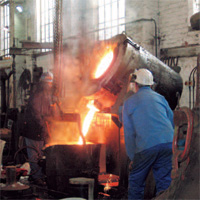
Pouring the molten metal into a
ladle
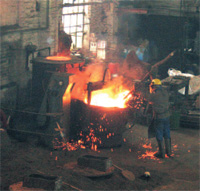
Stirring (polling) the metal with a
willow branch
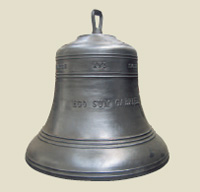
|











